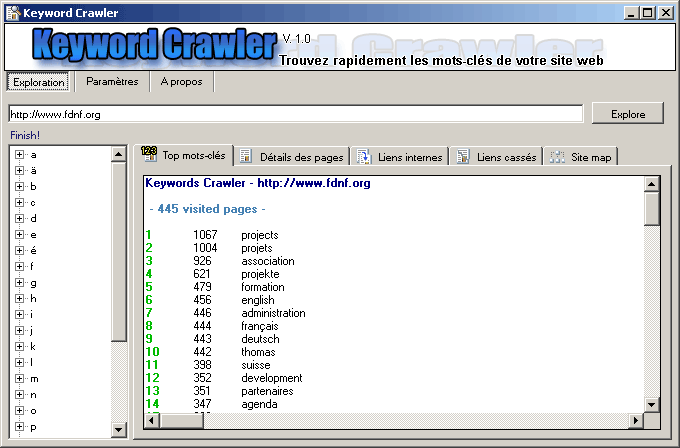If you’ve ever struggled to find the right keywords for your website, blog, or product pages, you’re not alone. Keyword research is one of th
If you’ve ever struggled to find the right keywords for your website, blog, or product pages, you’re not alone. Keyword research is one of the most important—and often frustrating—parts of SEO. Tools like Google Keyword Planner or other SEO software can be helpful, but they often provide limited, generic results.
That’s where a keyword lists crawler comes in.
Instead of relying solely on keyword suggestion databases, a keyword crawler scans real web content—competitor pages, blogs, product descriptions, forums—and pulls actual language used by people online. It gives you authentic, niche-specific keywords that are grounded in real-world usage, not just algorithmic guesses.
This guide will break down what keyword crawlers are, how to use them, what benefits they offer, and how to get started—even if you’re not a developer.
Must visit: activelifecare
What Is a Keyword Lists Crawler?
A keyword lists crawler is a tool that automatically scans websites and extracts keywords from their content. It works by crawling HTML pages, pulling out text from specific elements like titles, headings, meta descriptions, and paragraphs, and then filtering that text into usable keyword lists.
Unlike generic keyword research tools, which return pre-compiled lists based on historical search data, crawlers help you mine real-time content from websites and competitor pages to uncover how people actually write and talk online.

Why Use a Keyword Lists Crawler?
Here are just a few reasons why keyword crawlers are worth your time:
1. Real-World Keyword Data
You get actual words and phrases used in real content—blogs, product pages, reviews, FAQs—not just SEO database entries.
2. Uncover Hidden Long-Tail Keywords
Crawlers are great at surfacing long-tail, low-competition phrases that users naturally use but might not appear in standard keyword tools.
3. Analyze Competitors
Want to know what keywords your competitors are targeting on their landing pages? Crawl their sites and see exactly what they’re using.
4. Generate Content Ideas
By scanning blogs or forums in your industry, you’ll discover common questions, pain points, and trending topics that can guide your content strategy.
How Does a Keyword Lists Crawler Work?
Let’s walk through the process of how a typical crawler works:
Step 1: Define the Source
Decide where you want to pull keyword data from:
- Specific websites (competitors, niche blogs)
- A list of URLs
- Search results pages
- E-commerce listings
Step 2: Crawl and Extract Content
The crawler visits each page and extracts content from HTML tags:
- <title>
- <meta name=”description”>
- <h1> through <h6>
- Paragraphs
- Anchor text (links)
- Alt text (image descriptions)
Step 3: Clean and Filter the Text
Next, the crawler removes:
- Stopwords (e.g., “the”, “is”, “and”)
- Irrelevant data like numbers, symbols, boilerplate text
- Duplicate or repetitive terms
Step 4: Build the Keyword List
Keywords are grouped based on frequency or structure (single words, bigrams, trigrams), and you get a clean, organized list.
Step 5: Export for Use
Export your keyword data into a spreadsheet or database where you can analyze, sort, prioritize, and apply them to your SEO strategy.
How to Use a Keyword Lists Crawler in Real Projects
Let’s go through a few real-world scenarios where keyword crawlers are especially powerful.
🔹 Blog Strategy
Want to create a blog series in the fitness industry? Crawl the top 10 fitness blogs, extract their headings and subheadings, and you’ll have dozens of keywords to guide your posts.
🔹 E-commerce Optimization
Running a pet supplies store? Crawl Amazon or Chewy product pages to find high-converting keyword phrases like “eco-friendly dog shampoo” or “no-pull harness for large dogs.”
🔹 Local SEO
Building pages for a plumbing business in Chicago? Crawl other local service sites and directories to uncover how they describe their services—“emergency drain cleaning,” “same-day water heater repair,” etc.
🔹 Video or Podcast SEO
You can even crawl transcripts or video descriptions from YouTube or podcast platforms to find niche topics your audience is searching for.
How to Build a Basic Keyword Lists Crawler (No-Code + Code Options)
✅ No-Code Tools
If you’re not into programming, here are a few no-code or low-code options:
- Use a site audit tool with text export features
- Try Chrome extensions that extract page text
- Use spreadsheet formulas or simple AI tools to clean and group words
✅ Low-Code Option with Python
Here’s a basic outline using Python with requests and BeautifulSoup:
python
CopyEdit
import requests
from bs4 import BeautifulSoup
from collections import Counter
import re
url = “https://example.com”
response = requests.get(url)
soup = BeautifulSoup(response.text, “html.parser”)
text = soup.get_text()
words = re.findall(r’\b[a-z]{4,}\b’, text.lower()) # filter short/common words
keyword_counts = Counter(words)
for keyword, count in keyword_counts.most_common(30):
print(f”{keyword}: {count}”)
This script grabs the text, removes very short words, and counts keyword frequency.
Best Practices for Using a Keyword Lists Crawler
- Always respect robots.txt: If a site blocks crawlers, don’t force it.
- Use focused sources: Don’t crawl random sites. Stick to high-authority or niche-relevant pages.
- Update regularly: Content and keyword trends change—refresh your lists every few months.
- Cluster by topic: Organize keywords into themes (e.g., pricing, how-to, product features) for better content planning.
- Analyze before using: Not every word in your list will be useful. Check search volume, relevance, and user intent where possible.
FAQs About Keyword Lists Crawlers
1. Is it legal to use a keyword crawler?
Yes, as long as you respect site rules. Check each site’s robots.txt file to see if crawling is allowed. Avoid scraping personal or copyrighted content.
2. Can I crawl Google or YouTube search results for keywords?
Technically yes, but it’s against their terms of service. If you want to extract keyword ideas from search engines, use approved APIs or SEO tools instead.
3. What’s the difference between a crawler and a scraper?
They’re very similar. A scraper collects data from specific pages, while a crawler also navigates links and gathers data across multiple pages or entire websites.
4. Will I get banned for crawling a website?
If you send too many requests too fast, you might get rate-limited or blocked. Use delays and respect site rules to avoid this. For large jobs, consider rotating proxies.
5. How do I clean a messy keyword list?
Use spreadsheet functions or simple scripts to:
- Remove duplicates
- Filter out irrelevant terms
- Group similar keywords
- Apply keyword clustering for content topics
Conclusion
A keyword lists crawler is one of the most flexible and efficient tools you can use to supercharge your SEO and content strategies. It goes beyond what keyword planners offer by tapping directly into real web content—giving you access to actual phrases, questions, and terminology your audience uses every day.
Whether you’re building your own crawler or using a ready-made tool, integrating keyword crawling into your research process helps you stay ahead of trends, understand your competitors, and produce content that ranks better and resonates more.


COMMENTS